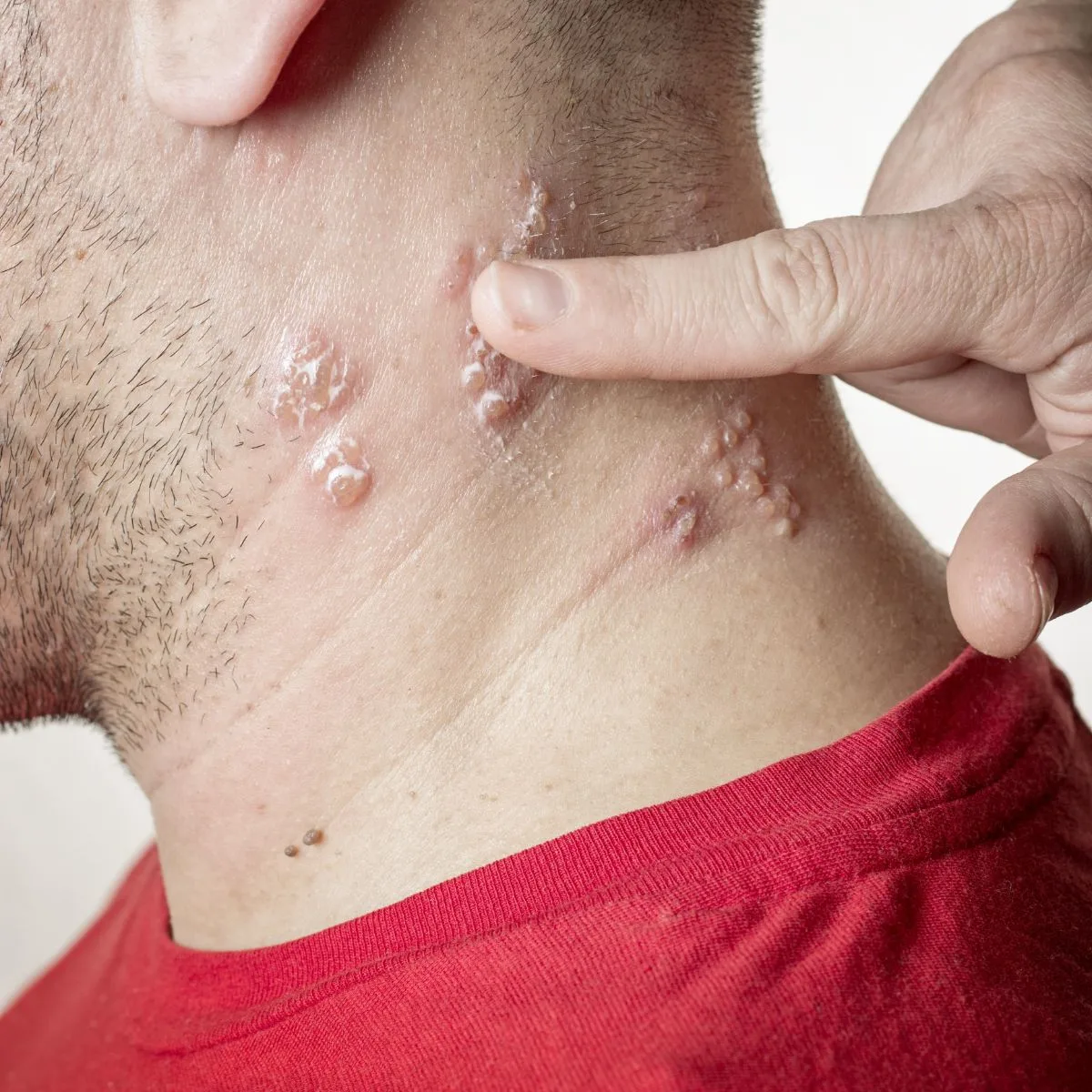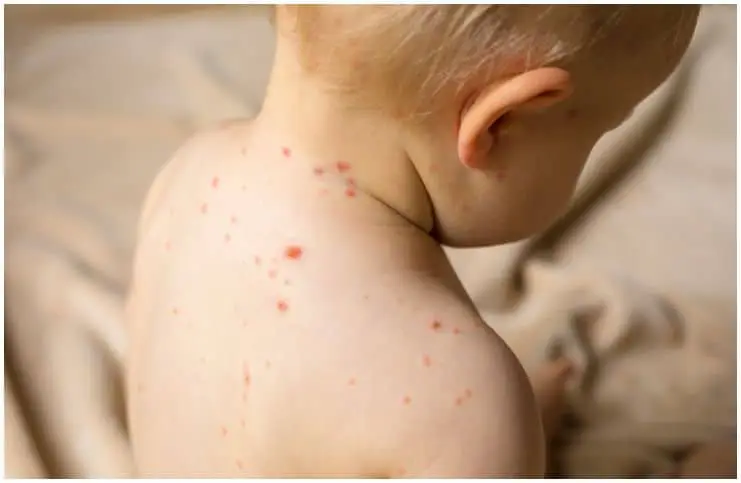Measles
Measles, also known as rubeola, is a very contagious viral illness which causes a distinct rash, cough, and fever.
It is caused by the highly infectious rubeola virus.
When an individual who has the virus coughs or sneezes, tiny droplets containing the virus spray into the air.
About 10 days after the virus is contracted, signs and symptoms become noticeable. Initial symptoms of measles include:
- a high fever that may reach 104F (40C);
- a runny or blocked nose;
- small greyish-white spots in the mouth;
- sneezing;
- aches and pains;
- watery eyes;
- loss of appetite;
- swollen eyelids;
- a general lack of energy;
- red eyes which may be sensitive to light;
- irritability;
- tiredness;
- a cough.
Approximately 2 days after initial symptoms appear, small, red, irregular spots with a whitish center (Koplik’s spots) develop on the inside of the cheeks near the molars.
Note – this infection is typically much more serious than German measles (rubella), chickenpox, or mumps.
Chickenpox
It is a very contagious infection caused by the varicella-zoster virus.
Signs and symptoms appear within 10 to 21 days after an individual has been in contact with someone who has the virus.
This infection causes an itchy rash and red spots all over the body.
The rash is associated with itchiness. After several days, the rash turns into blisters which become cloudy and form scabs.
See your healthcare provider right away if you develop any of the following symptoms:
- fever over 102 F;
- the rash spreads to one or both eyes;
- you can’t control your muscles;
- the rash gets warm, red, or tender;
- stiff neck;
- vomiting;
- shortness of breath;
- dizziness.
Note – kids typically miss 5 to 6 days of school due to chickenpox. During pregnancy, chickenpox poses certain risks.
Mumps
It is an extremely contagious viral infection of the salivary glands, which usually affects children.
The signs and symptoms typically develop 14 to 25 days after becoming infected with the mumps virus.
The following are the most common symptoms:
- muscle aches;
- discomfort in the salivary glands or the parotid glands;
- headache;
- difficulty chewing;
- loss of appetite;
- tiredness;
- fever;
- pain and tenderness of the testicles.
Note – although it isn’t proved, contracting this infection while you are pregnant, especially early on, may lead to miscarriage. Sometimes, mumps can cause hearing loss, in one or both ears.
Scarlet Fever
Scarlet fever, also known as scarlatina, is a bacterial infection which is caused by group A Streptococcus bacteria.
It is passed on through fluids from the nose and mouth.
Children aged 5 to 15 years have a substantially higher risk of developing scarlatina than other age groups.
Symptoms of scarlet fever include:
- a pale skin around the lips;
- red lines or streaks around the elbows, armpits, and knees;
- swollen glands in the back of the neck;
- flushed face;
- vomiting;
- nausea;
- swollen tonsils;
- a white tongue with red dots on the surface;
- headaches;
- chills;
- fever above 101°F (38.3°C);
- red, sore throat with yellow and white patches.
You can relieve these symptoms by:
- using calamine lotion to stop itching;
- eating soft foods to ease a sore throat;
- drinking cool fluids.
Note – if scarlatina goes untreated, the bacteria may spread to the:
- middle ear;
- blood;
- kidneys;
- skin;
- lungs;
- tonsils.
Shingles
Shingles is an infection that is caused by the varicella-zoster virus (this virus belongs to the Herpesviridae family), which is the same virus that causes chickenpox. In fact, you can only get shingles if you have had chickenpox.
Usually, you get shingles on your tummy and chest, however, it can appear on your eyes, face, and genitals.
In the United States, an estimated 1 in three Americans will develop shingles at some point during their lifetime. According to Statistics Canada, about 1 in three Canadians will develop shingles in their lifetime.
Most people who get the infection are 50 to 70 years of age, nevertheless, it can happen at any age.
Symptoms
The main symptom of shingles is pain (this can be a burning, constant dull, or gnawing pain, or stabbing pain that comes and goes), followed by a rash that develops into itchy blisters,
Other symptoms include:
- swollen glands (lymph nodes);
- fever;
- joint pain;
- headache;
- fatigue;
- malaise;
- difficulties with urination;
- nausea;
- upset stomach;
- chills;
- muscle pain and weakness.
Note – the shingles rash can last up to 30 days. Occasionally, the pain associated with shingles may linger.
Causes
It is caused by the varicella-zoster virus. It is not possible to catch the infection from someone with chickenpox or from someone with the condition.
READ MORE: Causes of Stuttering
Risk Factors
The reason why the varicella-zoster virus reactivates as shingles is not completely understood. However, it is thought that the following factors influence the development of the infection:
- taking drugs that weaken the immune system, like – medications given after an organ transplant;
- age, especially being 60 or older;
- having had radiation or chemotherapy treatment;
- sunburn to the skin;
- recent major surgery or illness;
- having diseases which weaken the immune system, like – AIDS, HIV, or cancer;
- emotional stress.
READ MORE: Spiritual Meaning of Cold Hands
Treatment
Treatment focuses on relieving symptoms and may include:
- acupuncture – it can be effective in relieving symptoms in some cases;
- pain relief medications like paracetamol;
- antibiotics – they may be needed if the skin rash becomes infected;
- cool compresses applied to the affected skin area;
- steroids may be prescribed if the pain and rash are severe;
- antiviral medications like aciclovir may be prescribed;
- creams and lotions may be prescribed for the rash.
READ MORE: Nail Biting – Spiritual Meaning
Spiritual Meaning of Childhood Illnesses (Measles, Chickenpox, Mumps, Scarlet Fever)
Childhood diseases, such as measles, chickenpox, scarlet fever, or mumps, are a sign of a new stage in the development of a child’s life.
Something that is unknown to the child appears visibly on the surface of the skin.
When these conditions follow their course, you will notice how the child becomes more mature. During the time of the disease, let your child know that everything is okay.
Tell him that life is a journey in which things are constantly revealed, and everything we discover in ourselves helps us to grow more.
READ MORE: Candidiasis – Spiritual Meaning
Spiritual Meaning of Shingles (Herpes Zoster)
Shingles is a condition that indicates a fear of the future that also involves negative thoughts.
The subtle causes of Shingles include long-term tensions, uncertainty, and indecision.
The associated pain is a result of the aggression that has not been released, and now it has turned against you, turning into self-aggression.
Images credit – Shutterstock
READ THIS NEXT: Spiritual Meaning of Cancer
References https://academic.oup.com/fampra/article/20/6/717/530889 https://study.com/academy/lesson/common-childhood-diseases.html

